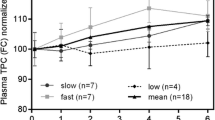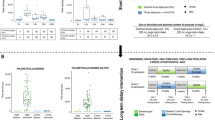Abstract
Background
The organic food sales have been increasing during the recent years. It has been hypothesised that organically grown fruits are healthier based on their higher content of phytochemicals. However, data on the bioavailability of phytochemicals from organically or conventionally produced plant foods are scarce.
Methods
Two human intervention studies were performed to compare the bioavailability of polyphenols in healthy men after ingestion of apples from different farming systems. The administered apples were grown organically and conventionally under defined conditions and characterised regarding their polyphenol content and antioxidant capacity. No significant differences in the polyphenol content and the antioxidant capacity from the organic and conventional farming system were observed.
Results
In the short-term intervention study, six men consumed either organically or conventionally produced apples in a randomized cross-over study. After intake of 1 kg apples, phloretin (C max 13 ± 5 nmol/l, t max 1.7 ± 1.2 h) and coumaric acid (C max 35 ± 12 nmol/l, t max 3.0 ± 0.8 h) plasma concentrations increased significantly (P < 0.0001) in both intervention groups, without differences between the two farming systems. In the long-term intervention study, 43 healthy volunteers consumed organically or conventionally produced apples (500 g/day; 4 weeks) or no apples in a double-blind, randomized intervention study. In this study, 24 h after the last dosing regime, the apple intake did not result in increasing polyphenol concentrations in plasma and urine compared to the control group suggesting no accumulation of apple polyphenols or degradation products in humans.
Conclusion
Our study suggests that the two farming systems (organic/conventional) do not result in differences in the bioavailability of apple polyphenols.


Similar content being viewed by others
References
Le Marchand L, Murphy SP, Hankin JH, Wilkens LR, Kolonel LN (2000) Intake of flavonoids and lung cancer. J Natl Cancer Inst 92:154–160
Tabak C, Arts ICW, Smit HA, Heederik D, Kromhout D (2001) Chronic obstructive pulmonary disease and intake of catechins, flavonols, and flavones—the MORGEN study. Am J Respir Crit Care Med 164:61–64
Knekt P, Jarvinen R, Reunanen A, Maatela J (1996) Flavonoid intake and coronary mortality in Finland: a cohort study. Br Med J 312:478–481
Knekt P, Isotupa S, Rissanen H, Heliovaara M, Jarvinen R et al (2000) Quercetin intake and the incidence of cerebrovascular disease. Eur J Clin Nutr 54:415–417
Barth SW, Fähndrich C, Bub A, Dietrich H, Watzl B et al (2005) Cloudy apple juice decreases DNA damage, hyperproliferation and aberrant crypt foci development in the distal colon of DMH-initiated rats. Carcinogenesis 26:1414–1421
Barth SW, Fähndrich C, Bub A, Watzl B, Will F et al (2007) Cloudy apple juice is more effective than apple polyphenols and an apple juice derived cloud fraction in a rat model of colon carcinogenesis. J Agric Food Chem 55:1181–1187
Knekt P, Kumpulainen J, Jarvinen R, Rissanen H, Heliovaara M et al (2002) Flavonoid intake and risk of chronic diseases. Am J Clin Nutr 76:568–569
Nicolas JJ, Richardforget FC, Goupy PM, Amiot MJ, Aubert SY (1994) Enzymatic browning reactions in apple and apple products. Crit Rev Food Sci Nutr 34:109–157
Awad MA, de Jager A, van Westing LM (2000) Flavonoid and chlorogenic acid levels in apple fruit: characterisation of variation. Sci Hortic 8:249–263
Rice-Evans CA, Sampson J, Bramles PM, Holloway DE (1997) Why do we expect carotenoids to be antioxidants in vivo? Free Radic Res 26:381–398
Brandt K, Molgaard JP (2001) Organic agriculture: does it enhance or reduce the nutritional value of plant foods? J Sci Food Agric 81:924–931
Carbonaro M, Mattera M, Nicoli S, Bergamo P, Cappelloni M (2002) Modulation of antioxidant compounds in organic vs conventional fruit (peach, Prunus persica L., and pear, Pyrus communis L.). J Agric Food Chem 50:5458–5462
Bourn D, Prescott JA (2002) Comparison of the nutritional value, sensory qualities, and food safety of organically and conventionally produced foods. Crit Rev Food Sci Nutr 42:1–34
Stracke BA, Rüfer CE, Weibel FP, Bub A, Watzl B (2009) Three-year comparison of the polyphenol content and the antioxidant capacity in organically and conventionally produced apples (Malus domestica Bork., cultivar Golden Delicious). J Agric Food Chem 57:4598–4605
Grinder-Pedersen L, Rasmussen SE, Bugel S, Jorgensen LV, Dragsted LO et al (2003) Effect of diets based on foods from conventional versus organic production on intake and excretion of flavonoids and markers of antioxidative defense in humans. J Agric Food Chem 51:5671–5676
Akcay YD, Yildirim HK, Guvenc U, Sozmen EY (2004) The effects of consumption of organic and nonorganic red wine on low-density lipoprotein oxidation and antioxidant capacity in humans. Nutr Res 24:541–554
Briviba K, Stracke BA, Rüfer CE, Watzl B, Weibel FP, Bub A (2007) Effect of consumption of organically and conventionally produced apples on antioxidant activity and DNA damage in humans. J Agric Food Chem 55:7716–7721
Weibel FP, Bickel R, Leuthold S, Alföldi T (2000) Are organically grown apples tastier and healthier? A comparative field study using conventional and alternative methods to measure fruit quality. Acta Hortic 7:417–427
Bub A, Watzl B, Blockhaus M, Briviba K, Liegibel U et al (2003) Fruit juice consumption modulates antioxidative status, immune status and DNA damage. J Nutr Biochem 14:90–98
Stracke BA, Rüfer CE, Bub A, Briviba K, Seifert S, Kunz C, Watzl B (2009) Bioavailability and nutritional effects of carotenoids from organically and conventionally produced carrots in healthy men. Br J Nutr 101:1664–1672
Briviba K, Schnäbele K, Rechkemmer G, Bub A (2004) Supplementation of a diet low in carotenoids with tomato or carrot juice does not affect lipid peroxidation in plasma and feces of healthy men. J Nutr 134:1081–1083
Watzl B, Bub A, Brandstetter BR, Rechkemmer G (1999) Modulation of human T-lymphocyte functions by the consumption of carotenoid-rich vegetables. Br J Nutr 82:383–389
Chinnici F, Bendini A, Gaiani A, Riponi C (2004) Radical scavenging activities of peels and pulps from cv. Golden Delicious apples as related to their phenolic composition. J Agric Food Chem 52:4684–4689
Escarpa A, Gonzalez MC (1998) High-performance liquid chromatography with diode-array detection for the determination of phenolic compounds in peel and pulp from different apple varieties. J Chromatogr A 823:331–337
Tsao R, Yang R, Christopher J, Zhu Y, Zhu HH (2003) Polyphenolic profiles in eight apple cultivars using high-performance liquid chromatography (HPLC). J Agric Food Chem 51:6347–6353
Rice-Evans CA, Miller NJ, Paganga G (1996) Structure-antioxidant activity relationships of flavonoids and phenolic acids. Free Radic Biol Med 20:933–956
Marks SC, Mullen W, Borges G, Crozier A (2009) Absorption, metabolism, and excretion of cider dihydrochalcones in healthy and subjects with an ileostomy. J Agric Food Chem 57:2009–2015
Hollman PCH (2004) Absorption, bioavailability, and metabolism of flavonoids. Pharm Biol 42:74–83
Kahle K, Huemmer W, Kempf M, Scheppach W, Erk T et al (2007) Polyphenols are intensively metabolized in the human gastrointestinal tract after apple juice consumption. J Agric Food Chem 55:10605–10614
Farah A, Monteiro M, Donangelo CM, Lafay S (2008) Chlorogenic acids from green coffee extract are highly bioavailable in humans. J Nutr 138:2309–2315
Rechner AR, Spencer JES, Kuhnle G, Hahn U, Rice-Evans CA (2001) Novel biomarkers of the metabolism of caffeic acid derivates in vivo. Free Radic Biol Med 30:1213–1222
Caris-Veyrat C, Amiot MJ, Tyssandier V, Grasselly D, Buret M et al (2004) Influence of organic versus conventional agricultural practice on the antioxidant microconstituent content of tomatoes and derived purees: consequences on antioxidant plasma status in humans. J Agric Food Chem 52:6503–6509
Lotito SB, Frei B (2004) Relevance of apple polyphenols as antioxidants in human plasma: contrasting in vitro and in vivo effects. Free Radic Biol Med 36:201–211
Lotito SB, Frei B (2004) The increase in human plasma antioxidant capacity after apple consumption is due to the metabolic effect of fructose on urate, not apple-derived antioxidant flavonoids. Free Radic Biol Med 37:251–258
Riso P, Visioli F, Gardana C, Grande S, Brusamolino A et al (2005) Effects of blood orange juice intake on antioxidant bioavailability and on different markers related to oxidative stress. J Agric Food Chem 53:941–947
Olthof MR, Hollman PCH, Vree TB, Katan MBK (2000) Bioavailabilities of quercetin-3-glucoside and quercetin-4’-glucoside do not differ in humans. J Nutr 130:1200–1203
Mullen W, Edwards CA, Crozier A (2006) Absorption, excretion and metabolite profiling of methyl-, glucuronyl-, glucosyl- and sulpho-conjugates of quercetin in human plasma and urine after ingestion of onions. Br J Nutr 96:107–116
Day AJ, Mellon F, Barron D, Sarrazin G, Morgan MR, Williamson G (2001) Human metabolism of dietary flavonoids: identification of plasma metabolites of quercetin. Free Radic Res 35:941–952
Rechner AR, Kuhnle G, Bremner P, Hubbard GP, Moore KP, Rice-Evans CA (2002) The metabolic fate of dietary polyphenols in humans. Free Radic Biol Med 33:220–235
Middleton E Jr, Kandaswami C, Theoharides TC (2000) The effects of plant flavonoids on mammalian cells: implications for inflammation, heart disease, and cancer. Pharmacol Rev 52:673–751
Acknowledgments
This work was supported by the Federal Agency for Agriculture and Food; Bundesprogramm ökologischer Landbau (04OE027). We gratefully acknowledge the excellent technical assistance of S. Häckel, E. Hoch, S. Merkel, G. Schultheiss, as well as L. Korn for his statistical consultations.
Conflict of interest statement
The authors have declared no conflict of interest.
Author information
Authors and Affiliations
Corresponding author
Rights and permissions
About this article
Cite this article
Stracke, B.A., Rüfer, C.E., Bub, A. et al. No effect of the farming system (organic/conventional) on the bioavailability of apple (Malus domestica Bork., cultivar Golden Delicious) polyphenols in healthy men: a comparative study. Eur J Nutr 49, 301–310 (2010). https://doi.org/10.1007/s00394-009-0088-9
Received:
Accepted:
Published:
Issue Date:
DOI: https://doi.org/10.1007/s00394-009-0088-9




